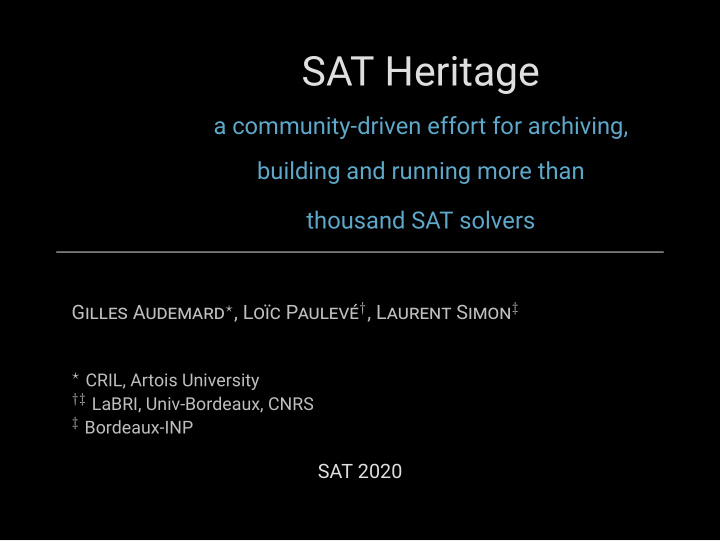



SAT Heritage a community-driven effort for archiving, building and running more than thousand SAT solvers GILLES AUDEMARD ⋆ , LOÏC PAULEVÉ † , LAURENT SIMON ‡ ⋆ CRIL, Artois University †‡ LaBRI, Univ-Bordeaux, CNRS ‡ Bordeaux-INP SAT 2020
Why such a tool? How to use? How to contribute? Future work and conclusion Why SAT Heritage? SAT has a long history of good practices source codes are widely distributed competitions are archiving and distributing sources But better practices are possible : reproducibility / reproduction compilation may not be easy (dependencies, languages, ...) long-term archiving of solvers is not easy each solver has its own set of parameters (may be not explicit in some papers) SAT 2020 July 2020 ☼ 2/13
Why such a tool? How to use? How to contribute? Future work and conclusion Many solvers, many (confmicting) dependencies Date #Solvers Collection Type Date #Solvers Collection Type ≤ 2000 24 Satex s / b 2011 104 Contest (2) s / b 2002 27 Contest (1) b 2012 65 Challenge - 2003 33 Contest (1) b 2013 140 Contest (3) s(*) / b(*) 2004 63 Contest (1) b 2014 150 Contest (3) s(*) / b(*) 2005 47 Contest (1) b 2015 31 Race (2) - 2006 16 Race (1) - 2016 32 Contest (4) s / b 2007 31 Contest (2) s / b 2017 71 Contest (4) s / b 2008 19 Race (1) - 2018 66 Contest (4) s / b 2009 64 Contest (2) s / b 2019 55 Race (3) s / b 2010 20 Race (1) - Total 1058 SAT 2020 July 2020 ☼ 3/13
Why such a tool? How to use? How to contribute? Future work and conclusion Why a tool (and not just a few repositories?) The tool must be easy to run (all included) One line to run them all The tool must provide the basis for a community effort SAT 2020 July 2020 ☼ 4/13
Why such a tool? How to use? How to contribute? Future work and conclusion SAT Heritage : built on tools designed to last Archiving and versioning of SAT Heritage Archiving (large files) / DOI for referencing Container solutions for Linux images Guix Detailed Linux Images (reproducibility) SAT 2020 July 2020 ☼ 5/13
Why such a tool? How to use? How to contribute? Future work and conclusion Why using Docker? 1/2 Docker is a recent set of tools (2013) aiming and ”simulating” virtual OS inside a Docker Engine. On Linux, Docker is like a chroot command (with tons of other functions) Filesystems are handled incrementally : Two docker images of two SAT solvers built on the same base share all the libraries, except the SAT solver binaries It is space efficient SAT 2020 July 2020 ☼ 6/13
Why such a tool? How to use? How to contribute? Future work and conclusion Why using Docker? 2/2 In our tool, a docker image is built temporarily to compile the solver. Then, only the necessary binaries are kept inside the container to optimize the space. about efficiency : Docker images are widely used on clusters to allow users to use their own libraries/tools There is almost no lost in performances on Linux machines On MacOS, the docker engine has to be run inside a virtual machine SAT 2020 July 2020 ☼ 7/13
How to use it?
Why such a tool? How to use? How to contribute? Future work and conclusion How to use it? See Demonstration by G. Audemard SAT 2020 July 2020 ☼ 9/13
How to contribute?
Why such a tool? How to use? How to contribute? Future work and conclusion How to contribute? See Demonstration by L. Paulevé SAT 2020 July 2020 ☼ 11/13
Future work and conclusion
Why such a tool? How to use? How to contribute? Future work and conclusion What’s next? an easy integration with SAT competitions better integration of proofs (proof checkers included in containers) special branches for prolific authors digital signatures for ”certified by authors” solvers with command lines build another tool for benchmarks generation maintain it SAT Heritage is in your hands SAT 2020 July 2020 ☼ 13/13
Recommend
More recommend